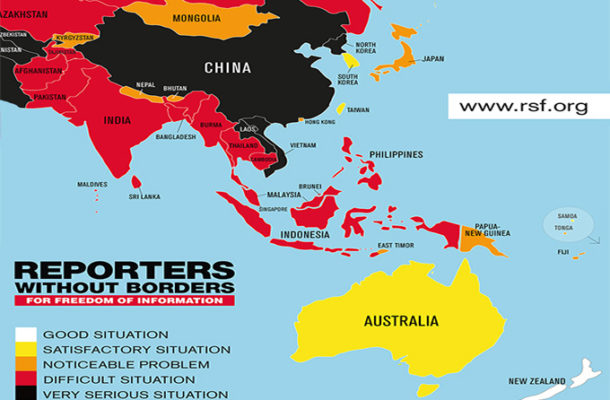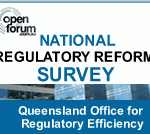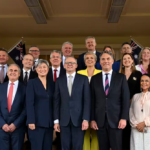Press censorship clouds the Asia-Pacific

The Chinese model of state-controlled news and information is being copied in other Asian countries, according to the Paris-based Reporters Without Borders group in its latest World Press Freedom Index.
Published every year by RSF since 2002, the World Press Freedom Index measures the level of media freedom in 180 countries, including the level of pluralism, media independence, the environment and self-censorship, the legal framework, transparency, and the quality of the infrastructure that supports the production of news and information.
In the Pacific, both Tonga (51st) and Papua New Guinea (53rd) have dropped two places in the international press freedom rankings, and Samoa one place to 22nd.
The biggest climbs were by Fiji (up 10 places to 57th), New Zealand (five places to 8th), putting it back into the top 10 around the world, while Timor-Leste improved three places to 95th. The Solomon Islands was unranked while Australia remained in 19th, due to its concentrated media ownership.
The Pacific
In the Pacific, Papua New Guinea is at 53rd place, losing two ranks. Papua New Guinea’s media are diverse and dynamic and enjoy a relatively free environment, but journalists are still subject to violence. There were several cases in 2017 of journalists being the targets of police violence. Some officials encourage media self-censorship by directly threatening journalists whose articles criticise them.
Tonga lost two ranks, pulling back to 51st place. Independent media outlets have increasingly assumed a watchdog role since the first democratic elections in 2010. However, some political leaders have not hesitated to sue media outlets, exposing them to the risk of heavy damages awards. Some journalists say they are forced to censor themselves because of the threat of being bankrupted.
Samoa slipped a place to 22nd on the index. Despite the liveliness of media groups such as Talamua Media and the Samoa Observer Group, and individual newspapers such as Iniini Samoa, this Pacific archipelago is at risk of losing its status as a regional press freedom model.
The law criminalising defamation was repealed in 2013, raising hopes that were finally dashed in December 2017, when Parliament restored the law under pressure from Prime Minister Tuilaepa Sailele Malielegaoi.
While the Solomon Islands was not ranked, the country still theoretically enjoys free speech and media freedom, which are guaranteed by article 12 of the constitution. However the defamation law continues to intimidate journalists and encourage a degree of self-censorship in the media, and Indonesian diplomatic pressure for an end to any form of support for West Papuan self-determination could pose a threat to the public debate.
Timor-Leste
Timor-Leste rose three ranks to 95th in the Index. No journalists have been jailed in connection with their work in Timor Leste, a country with just 1.2 million inhabitants, since it won independence in 2002.
While Articles 40 and 41 of its constitution guarantee free speech and media freedom, various forms of pressure are used to prevent journalists from working freely, including intimidatory legal proceedings, police violence and public denigration of media outlets by government officials or parliamentarians.
Fiji
Fiji has moved up 10 places to 57th in 2018. The adoption of a new constitution in 2013 and the ensuing parliamentary elections in September 2014—the first since the 2006 coup d’état—had a positive impact on access to information.
This could be seen in the public debate and pluralistic coverage during the election itself despite some problems in the run-up. The media are nonetheless still restricted by the draconian 2010 Media Industry Development Decree and the Media Industry Development Authority (MIDA) that it created. Coverage of the 2018 parliamentary elections will be a decisive test for Fijian press freedom.
Australia and New Zealand
Although near the top of the Index, Australia‘s press freedom is hampered by its concentration of ownership – a problem reflected in other parts of its economy. The 5 place rise of New Zealand to 8th shows that government action to encourage a diversity of views can be effective.
New Zealand‘s authorities blocked a proposed merger between the country’s two biggest media groups, thereby ensuring continued media pluralism and independence with new guarantees. At the same time, investigative reporting should soon be strengthened by a law protecting whistle-blowers.
North Korea
Asia still has the world’s worst violator of individual freedom with North Korea standing 180th and last in the global ranking. The recent widespread adoption of smartphones in North Korea has unfortunately been accompanied by draconian control of communications and the national intranet.
The state news agency KCNA is the only authorised source of news for all of the country’s media and merely reading, viewing, or listening to a foreign media outlet can lead to a spell in a concentration camp.
China
Despite – or perhaps because of – its embrace of the global economy, China’s repression of its citizens is hardly less draconian than their North Korean allies. China stands unchanged at 176th in the Index, the fourth most repressive country in the world. Under the self-declared autocracy of Xi Jinping, China is recreating a contemporary version of the totalitarianism it endured under the murderous reign of Chairman Mao.
During President Xi’s first term, censorship and surveillance reached unprecedented levels through the massive use of new technology which western analysts once hoped would open information to its people. Foreign reporters are finding it harder to work and ordinary citizens can now be jailed for sharing content on a social network or during a private chat on a messaging service.
China’s ‘social credit’ scores can now prohibit individuals seen as trouble makers from owning property, finding a job or even buying an airline ticket. More than 50 professional and non-professional journalists are currently detained by the Chinese regime, and many of them have suffered a combination of mistreatment and a lack of medical care that poses a threat to their lives.
Liu Xiaobo, a Nobel peace laureate and recipient of RSF’s Press Freedom Prize, and the dissident blogger Yang Tongyan both died last year from cancers that were left untreated in detention.
As well as erecting its ‘great internet wall’ to prevent its citizens having access to alternative news sources, the Chinese government is also trying to establish a “new world media order” under its influence, by exporting its oppressive methods, information censorship system and internet surveillance tools.
Predictably enough, communist China’s unabashed desire to crush all pockets of public resistance is finding imitators among would-be despots in Asia.
Vietnam
This trend can be seen in communist Vietnam, which lies at 175th place, just one place above China. Although Vietnam has seen some liberalisation of its economy, its media remain entirely state controlled, and while a handful of citizen-journalists defend the freedom to inform with great courage, the government’s response has been brutal.
Bloggers used to be sentenced to two years in prison, but now those who blog about banned subjects such as corruption or environmental disasters in the nation can expect a 15-year jail term.
Cambodia
Although Pol Pot’s genocidal regime has been consigned to history, Cambodia is another country which is taking China’s road towards ever greater repression. It has fallen 10 places in the Index to 142nd, one of the biggest declines in the region. Prime Minister Hun Sen’s regime launched a ruthless offensive against media freedom in 2017, shutting down more than 30 independent media outlets and jailing several journalists in a completely arbitrary manner.
His suppression of independent voices, increased dominance of the mass media and the meticulous control of social media are a disturbing echo of the methods used in China, which has invested millions of euros in Cambodia’s pro-government media. The Chinese model’s influence is also felt by the media in Thailand (140th), Malaysia (145th) and Singapore (151st).
Myanmar
The other major casualty in the region is Myanmar. The state formerly known as Burma has fallen six places to 137th. While she was once a dissident against a hardline military government herself, the government led by Aung San Suu Kyi has done little to defend the role of the media in a functioning democracy since the start of the Rohingya crisis in August 2017.
The United Nation now accepts that “elements of genocide” and “ethnic cleansing” occurred but proper reporting on events from within Myanmar is still impossible because the military continue to deny access. Two Reuters reporters who tried to investigate the crisis still languish in prison.
Myanmar’s coverage of the Rohingya crisis has been marked by the growth of hate messages on social networks, especially Facebook, which in turn has encouraged self-censorship within the media.
The Philippines
In the Philippines, which has slipped six places at 133rd, the media has been checked by the strong man tactics of President Rodrigo Duterte who lost no time in warning the “sons of whore journalists” that criticism would not be tolerated. There have been countless examples of Philippine government harassment of media that voice any concern regarding Duterte’s “war on drugs.”
Here again, verbal violence and physical violence are closely linked. With four journalists murdered in connection with their work in 2017, the Philippines is one of the continent’s deadliest countries.
Pakistan and Afghanistan
The high level of violence to which reporters are exposed in Pakistan (139th) accounts for its failure to rise in the index. Subjected to death threats, abduction and torture, journalists are still threatened by both Islamic fundamentalists on the one hand and by the all-powerful intelligence services on the other.
Violence is even more worrying in neighbouring Afghanistan (118th), where 18 journalists and media workers were killed in 2017. It nonetheless rose two places in the Index, above all because of an improvement in the legal environment with the creation of coordinating committees for the safety of journalists and media.
These committees handled around 100 cases in the past year, with the result that in some cases sanctions were imposed on senior civilian and military officials.
Similarly, the efforts undertaken in Sri Lanka to combat physical attacks against media personnel and impunity for acts of violence against journalists account for its 10-place rise in the Index to 131st.
Asia
Despite an overall improvement in the media environment in Mongolia, pressure on the media during the presidential election accounts for its slight fall (down two places at 71st). Japan’s rise (up five places at 67th) reflects a relative easing in pressure on the media from Shinzo Abe’s nationalist government, although journalists are still constrained by the weight of tradition and business interests.
Hong Kong (70th) and Taiwan (42nd) each rose three places, resisting China’s growing influence in their different ways. South Korea (up 20 places at 43rd) rose more than any other country in the Asia-Pacific region. After a string of corruption scandals, the new president, Moon Jae-in, has helped to resolve a conflict between journalists and management at the public broadcasting service.
However structural problems still need addressing in South Korea, including the decriminalising of defamation and repealing a national security law that continues to threaten journalists.

Open Forum is a policy discussion website examining the social, political, economic, cultural and environmental issues of today. We welcome contributions and invite you to follow us on Twitter, Linkedin, Federated Press and Vivaldi Social. We #StandwithUkraine.












